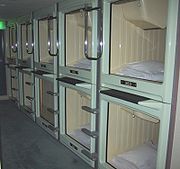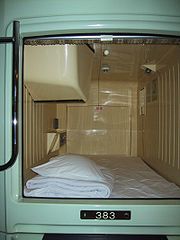
Capsule hotel
Encyclopedia


Description
The guest space is reduced in size to a modular plastic or fiberglassFiberglass
Glass fiber is a material consisting of numerous extremely fine fibers of glass.Glassmakers throughout history have experimented with glass fibers, but mass manufacture of glass fiber was only made possible with the invention of finer machine tooling...
block roughly 2 m by 1 m by 1.25 m, providing room to sleep. Facilities range in entertainment offerings (most include a television, an electronic console, and wireless internet connection). These capsules are stacked side by side and two units top to bottom, with steps providing access to the second level rooms. Luggage is stored in a locker. Privacy is ensured by a curtain or a fibreglass door at the open end of the capsule. Washrooms are communal and some hotels include restaurants (or at least vending machine
Vending machine
A vending machine is a machine which dispenses items such as snacks, beverages, alcohol, cigarettes, lottery tickets, consumer products and even gold and gems to customers automatically, after the customer inserts currency or credit into the machine....
s), pools, and other entertainment facilities.
This style of hotel accommodation was developed in Japan and has not gained popularity outside of the country, although Western variants known as "Pod hotels" with larger accommodations and often private baths are being developed. Guests are asked not to smoke or eat in the capsules.
Capsule hotels vary widely in size, some having only fifty or so capsules and others over 700. Many are used primarily by men. There are also capsule hotels with separate male and female sleeping quarters. Clothes and shoes are sometimes exchanged for a yukata
Yukata
A is a Japanese garment, a casual summer kimono usually made of cotton. People wearing yukata are a common sight in Japan at fireworks displays, bon-odori festivals, and other summer events. The yukata is also frequently worn after bathing at traditional Japanese inns...
gown and slippers on entry. A towel may also be provided. The benefit of these hotels is convenience and price, usually around ¥2000-4000 (US$26–52) a night.
Certain visitors (especially on weekdays) are too inebriated to safely travel to their homes, or too embarrassed to face their spouses. With continued recession in Japan, as of early 2010 more and more guests—roughly 30% at the Capsule Hotel Shinjuku 510 in Tokyo
Tokyo
, ; officially , is one of the 47 prefectures of Japan. Tokyo is the capital of Japan, the center of the Greater Tokyo Area, and the largest metropolitan area of Japan. It is the seat of the Japanese government and the Imperial Palace, and the home of the Japanese Imperial Family...
-- were either unemployed or underemployed and were renting capsules by the month.
History
The first capsule hotel to open was the Capsule Inn Osaka, designed by Kisho Kurokawa and located in the UmedaUmeda
Umeda is the main commercial and central business district in Kita-ku, Osaka, Japan, best known as the city's main northern railway terminus .Umeda is a large traffic hub, as well as the principal office and hotel district...
district of Osaka
Osaka
is a city in the Kansai region of Japan's main island of Honshu, a designated city under the Local Autonomy Law, the capital city of Osaka Prefecture and also the biggest part of Keihanshin area, which is represented by three major cities of Japan, Kyoto, Osaka and Kobe...
. It opened in 1979.
External links
- Japan's Capsule Hotels (article)

